Moose Hunt in Icy Bay
Story by Marcus Weiner
Photos by Brian Woobank
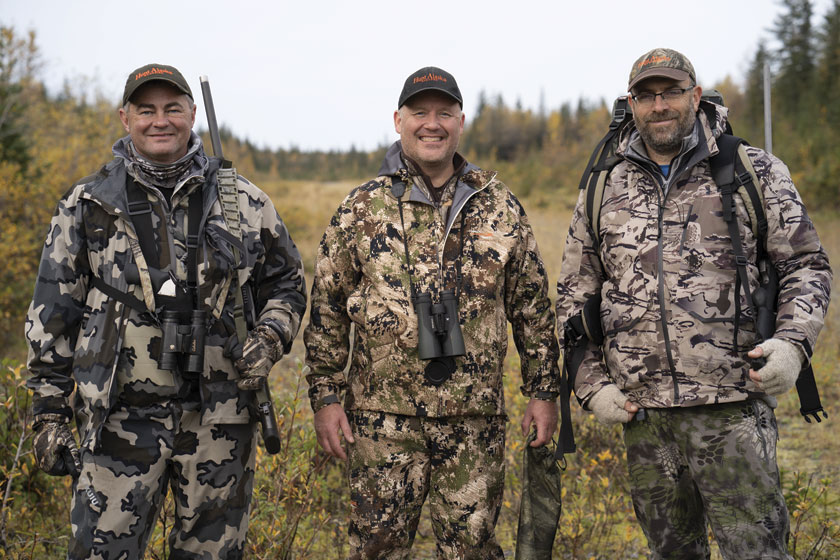
Left to right: Brett Gildemaster, Kirk Studebaker and the author make for a solid moose-hunting team. These guys are rock solid: great attitudes, hard workers, love to hunt and relish the chance to be in the field. They are founding members of Team Hunt Alaska.
DIY Moose Hunt in Icy Bay
For the last three minutes, “Young Guns” has been on a beeline to my cow call. My loud calls, bolstered by the use of Wayne Kubat’s “Bull Magnet,” which is essentially a fiberglass megaphone that allows me to amplify both cow calls and bull grunts, has drawn in this big bull from far away. At first, far in the distance, I could hear the faint vocalizations of a bull drawn to a cow. The rhythmic “Ooh-Waa” sounds are repeated by the bull every few seconds. Finally, at about 400 yards across the swamp, I get a visual on the bull as he milled around.
At first it appears that the bull is going to head off in another direction, but my persistent calling has him coming on a string. The topography of the location makes it so I won’t be able to get a shot until he comes clear of the brush that separates us, which will put him broadside at 20 yards. I experience a full adrenaline rush after so much communication with this bull, and have enough time to calm down my heartbeat as Young Guns closes the gap. At 30 yards, a swirling wind alerts the bull of my presence, and he pulls up, spooks and bolts. At that moment, I was understandably crestfallen. In hindsight, the experience was incredible and part of the reason why hunting moose is so exciting.
For many who have never DIY-hunted moose, the logistics of choosing a location, figuring out what gear to bring, learning how to find moose and call them in, and then finally butchering and packing out the animal, make for a significantly daunting task. The purpose of this article is to shed some light on each aspect of a DIY moose hunt in order to help more hunters succeed in pursuing the biggest deer species in the world.
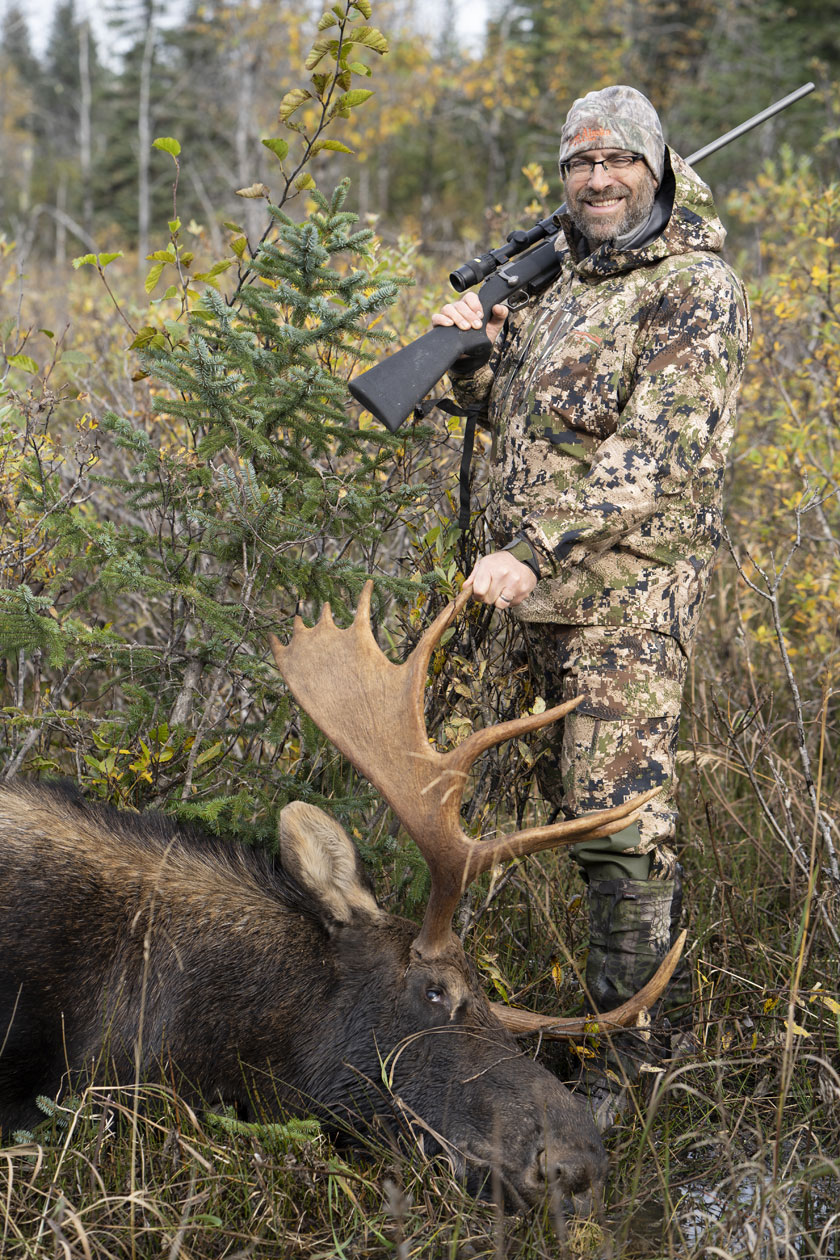
The author poses with his moose. A team effort is recommended when hunting the biggest deer species in the world.
Big Chocolate
By law, hunters in Alaska are not allowed to shoot moose on the same day they fly. I can understand this as pilots in small planes could spot moose from the air, land, and shoot, and that provides an unfair advantage for the hunter.
We arrive on a Sunday, and have plenty of time to scout, put out some scent and call. Moose can take up to several days to come to a call, so it makes sense to go out and vocalize, even when you can’t pull the trigger.
We split into two-man teams. Brian and I will hunt together, me with the rifle and Brian with the camera, and Kirk and Brett will work together to find moose. Kirk is here to provide hunt support, help butcher, pack and serve as camp cook. Brett has a moose tag and will be trying to take down a bull.
After scenting the area with moose urine products made by Bait Em 907, surveying the country and calling for several hours, Brian and I decide to head back to camp while Kirk and Brett forge further into the backcountry to search for good-looking places to post up and call. When you use a transporter in Alaska to provide hunting support, they are not allowed to provide any tools or share any information about where to hunt. We are on our own and use this first day to learn the area.
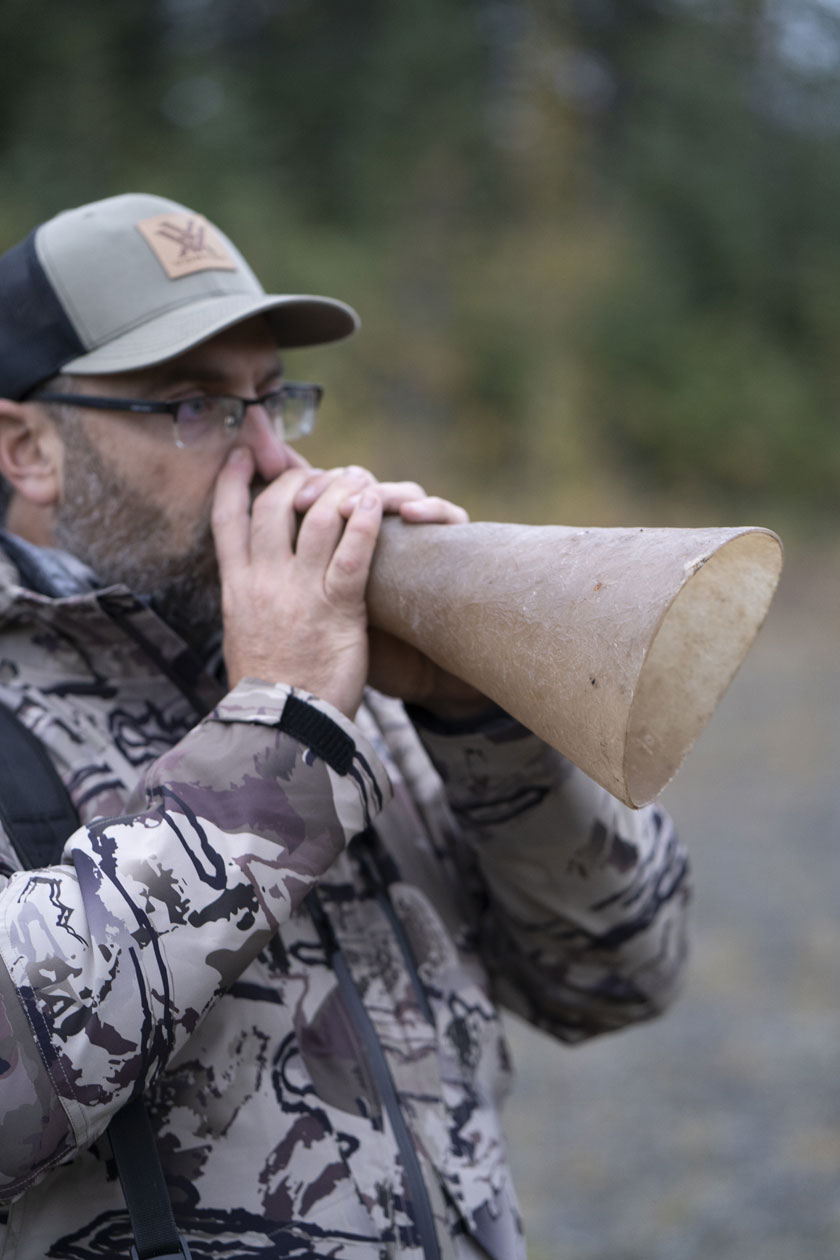
The Bull Magnet is a fiberglass megaphone that hunters can use to call and scrape brush.
It’s typical weather in southeast Alaska; raining steadily and accompanied by a stiff breeze. As Brian and I get within 1/2 mile of camp, I hear a grunt behind me, which sounds like an “Uhhh.” When I hear it again, I turn to look over my right shoulder and “Big Chocolate” is staring at me from 50 yards away. I alert Brian to get the camera rolling, and slowly walk away from the bull. Talking to the camera, I explain that we can’t shoot on the same day we fly, or I would drop this bull right now. He appears to have at least a 50-inch spread on his rack, and tall, wide main palms that are dark chocolate in color. I conclude on film that we will ease our way out of the area, try and put this bull to bed, and come right back in the morning to try and draw him out. Unfortunately, he doesn’t comply with our wishes, but the interaction fills the team with great expectation that we will be seeing bulls during the hunt. It also proves that my calls are effective.
Ethical Shots and the Old Man
Surprisingly, neither hunting team saw any moose on Day 1 of the hunt. Day 2 rolled out fairly dry with a mild wind, so Brian and I post up in the same location where we interacted with Big Chocolate. Thirty minutes into the morning, I hear some brush breaking, and it’s clear that a moose is coming to the call. He doesn’t emit any grunts, so I am not sure if it’s a bull or cow. Both Brian and I get into position, as a wary bull works toward the edge of the forest, staring at me from the brush, in between two sections of swamp. Two thoughts are in my mind: 1) Don’t drop this bull in the water. Butchering a 1200-pound animal in three feet of water is not my idea of fun. 2) Based on how Big Chocolate behaved, I figured I had a good chance of convincing this bull to come to me.
The moose was wary of me; I realized after the fact that the wind had started to swirl, when it was previously in my face. He stopped and stared at me at 125 yards. Most of his body was hidden in the brush, and I had a look at his head and rack. He was an older bull, and worth shooting, but I didn’t want to take a bad shot and risk wounding it and having it run off. I tried to persuade the old bull to take a few more steps towards me, but he wasn’t having it. He came out of the brush, quartered away, and trotted off. So close! In hindsight, I think I made the right call. One of our most important jobs as hunters is to take ethical shots. Sure, I could have easily hit this moose and most likely could have dropped it, but taking the risk of having the bullet deflect off tree limbs, and wounding a moose that I could potentially lose, wasn’t the right call.
The Fighter
After three previous encounters with bulls, I was optimistic that we would get a moose on the ground soon. Hunting in a new area, with the thought of easing the pressure on the bulls we’d been chasing, and to come back to them later, Brian and I set up in a meadow with the wind in our face. I began my sequence of calling and settled in on high alert.
In classic moose fashion, a bull snuck in behind us, trying to wind us. Brian spotted him creeping in about 125 yards away, and we flattened to the ground in an attempt to remain unnoticed. After 10 heart-pounding seconds, I sprung into action. Popping up, I chambered a round and took about 10 steps to the nearest tree to get a rest. The bull spotted me and began to move away, but remained broadside. Wasting no time, I anchored him with a solid shot. He came towards us and quartered away, while I scrambled through the willow and aspen that separated us. One more roar from the rifle and the bull tottered, before going down. Moose hunting is like that; hours of quiet and inactivity, followed by minutes of frenzied chaos.
I labeled this bull “The Fighter.” He’d broken off most of the main palm on one side, no doubt in rutting battles with other bulls. We all gathered around to say thanks to the animal and pay our respects. We marveled at the moose before us and high-fived our success. As a group, we’d agreed to share the moose among the four of us, so my success was everyone’s success. That’s the way we do it on team Hunt Alaska.
Icy Bay Lodge
Todd Robertson is the owner of Icy Bay Lodge. His fishing lodge is beautifully constructed, well appointed, and offers a high-end experience for both saltwater and freshwater anglers. We visited on the last evening of the hunt to enjoy a meal and get a hot shower. I’m looking forward to my next visit to sample the fishing program.
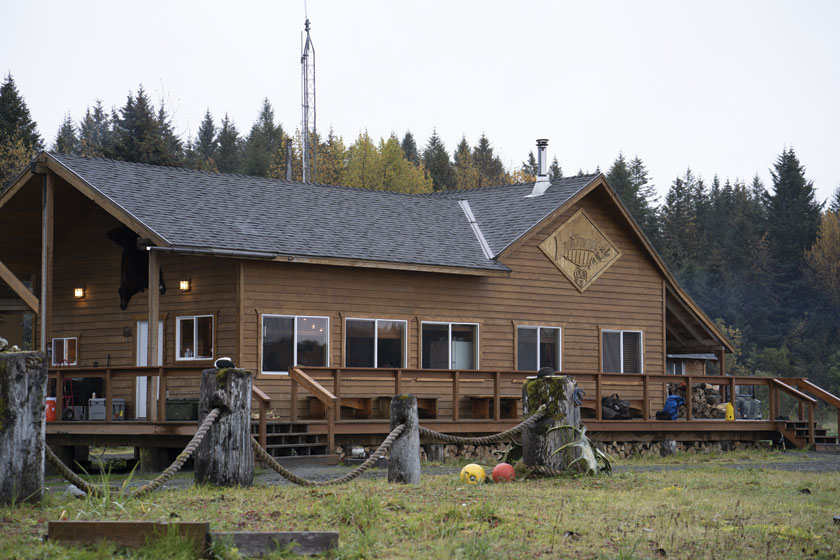
Icy Bay Lodge is beautifully appointed and sits right on Icy Bay.
Icy Bay Lodge’s hunting program is unique. They lease native-owned land and have the only access to 110 square miles of prime habitat. Since access is limited, ADF&G has set liberal rules for GMU 5B. Hunters (both residents and nonresidents) need to get a registration permit through ADF&G (this is not a draw; it’s currently a guaranteed permit, RM062), which allows them to take one bull of any size. Yes, you read that correctly, any bull is legal. One of the biggest concerns with DIY moose hunters is shooting a moose that is sub-legal. It can be difficult to tell the difference between a 49-inch and a 51-inch moose and those two inches make a big difference in the outcome. No worries here. If it has antlers, it’s legal.
Hunters operating from Icy Bay Lodge are transported to one of two remote cabins and given food to cook for themselves. There’s also an outpost that has a tent and a cook shack, and Todd has plans of bringing in several movable camps.
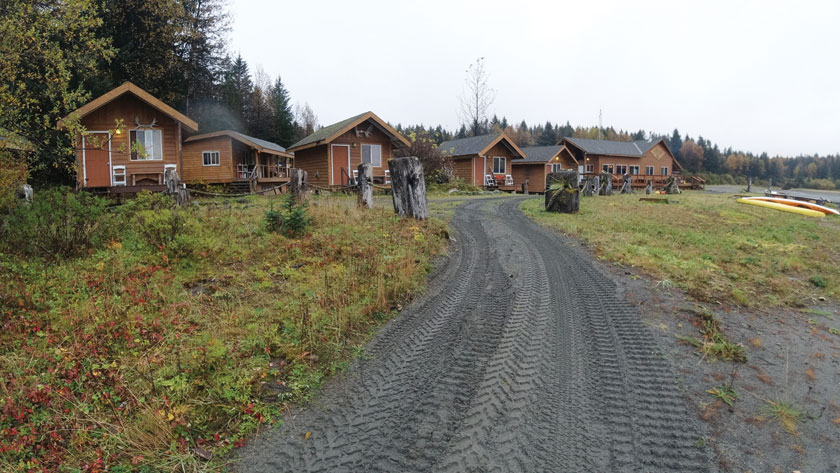
Guests stay in private cabins when fishing from Icy Bay Lodge.
Hunters should plan on bringing a communication device to stay in touch with the lodge. I brought a ZOLEO satellite communication device and was able to text the lodge when I needed transportation or additional supplies for camp. The ZOLEO unit worked perfectly, I highly recommend it, and used it successfully across Alaska in 2020. You buy the device for a reasonable price and then sign up for a monthly service plan. Pricing options vary from a small usage fee per month to an unlimited program and the service has been completely reliable. On the day we were flying out, Todd was able to text me and let me know that the plane was going to arrive a few hours later than originally planned, and that level of communication and service in the bush was made possible with this unit.
Location, Tools and Game Plan for Your Moose Hunt
Location
The first step in planning a moose hunt is deciding on location. In some areas of the state, hunters have to draw tags to hunt for moose. Hunters put in for draw-hunt tags in early December. ADF&G closes the submission period by the middle of December and tags are announced in February. In many of these locations, Alaska residents can hunt without drawing a tag, while nonresidents need to draw a tag. In other parts of the state, hunters simply need a harvest ticket to hunt moose. In most of those locations, there are size restrictions on the bull moose you can harvest. In general, a bull with a rack width of 50 inches or larger is legal. Most hunters approximate the skull width at 10 inches, so if you clearly have twice the skull width of antler on both sides of the skull, then you are in the ballpark. Another measurement device used by ADF&G to determine legal bulls is the number of brow tines. The brow palm is the part of the antler closest to the skull and is delineated from the main palm by a defined “bay” between the sections—basically a large gap that separates the brow palm from the main palm. ADF&G defines legal bulls by three- or four brow-tine delineations, meaning in some areas a hunter can shoot moose with three brow tines (on either side) and in some areas, four brow tines are mandatory. ADF&G defines a point or tine as, “A point or tine is an antler projection at least 1 inch long, and longer than it is wide, with the width measured 1 inch or more from the tip; an antler point or tine originating within 2 inches from the base, and less than 3 inches in length will not be counted as a brow tine or point.” As mentioned previously, Icy Bay Lodge resides in a remote section of Alaska where access is difficult, so any bull moose is legal.
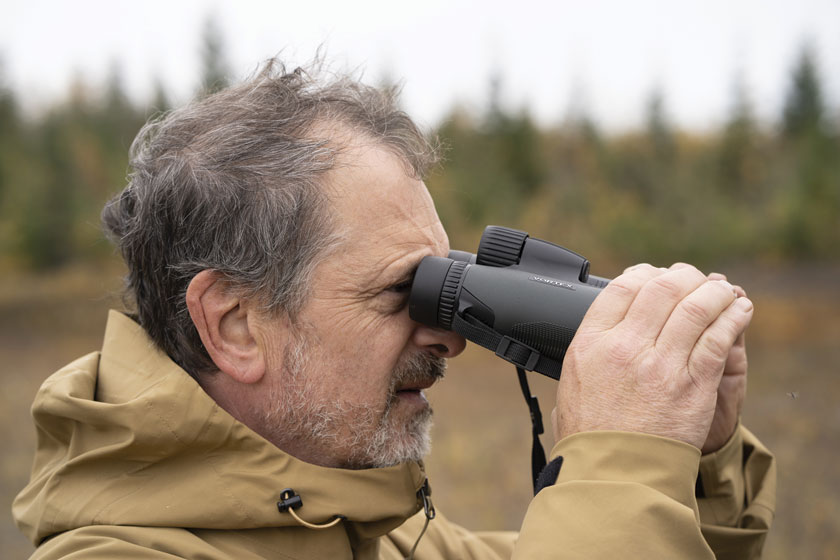
Brian using a Vortex Diamondback HD 15×56 binocular to glass for moose.
Some hunters want to shoot the largest moose they can find, while others are after younger bulls for the freezer. Determine what you want and choose the area of the state that best offers those opportunities. Part of the decision should be based on what tags you draw. Part of the decision should also be based on your choice of transporter. Breaking that element down further, some areas of the state with great moose populations are very difficult to access, and popular destinations with plenty of access can get crowded. I suggest that you get your hunting team together, weigh in evenly on your priorities, and come to a group consensus. I’ve done DIY moose hunts in Southeast, Southwest and Southcentral and each destination has its pros and cons.
Game Plan
Though one person is capable of cutting up a moose, two is much better and three makes it even easier. Having a third set of hands to help pull down on the hide while skinning, to help lift the rear quarters making it easier for the cutter to separate the hip joint, and to help in lifting quarters to place them in game bags, is a big advantage. In our case, it also made it possible for one person to start packing meat to where the transporter could pick it up, while the other two finished cutting up the bull. So, if possible, have at least three on your moose-hunting team.
One of the primary concerns when shooting a moose is how far you will have to pack the animal out of the field. When using a transporter, you’ve got to get the animal within a short distance of their transportation device, like within 25 yards, and then they can help you. With that said, decide as a group how far you are willing to pack heavy loads of meat. Accounting for meat, bone, skull and antlers of an average, adult field-dressed bull, you may be hauling out 700-1000 pounds of moose. I recommend you spend time getting into shape to haul that kind of weight by doing a combination of cardio and strength training. That will extend your effective range. Be realistic about how far you can pack your animal, and the terrain and fitness of the group are part of that equation. The older I get, the shorter I am willing to pack a moose, so I generally keep the meat packing distance to one mile, preferably much closer.
The next step is to determine where you will spend the majority of your time hunting. Moose love water and have earned the nickname “swamp donkey.” In addition to browsing on willow, aspen, birch and alder, moose key in on aquatic plants and they also need to ingest a large amount of water. With these concepts in mind, scouting the country you will be hunting, both in person and by looking at maps of the area, will help you locate good spots from which to call. When you are scouting in person, look for tracks, droppings, rubs and wallows to confirm that moose are in the area.
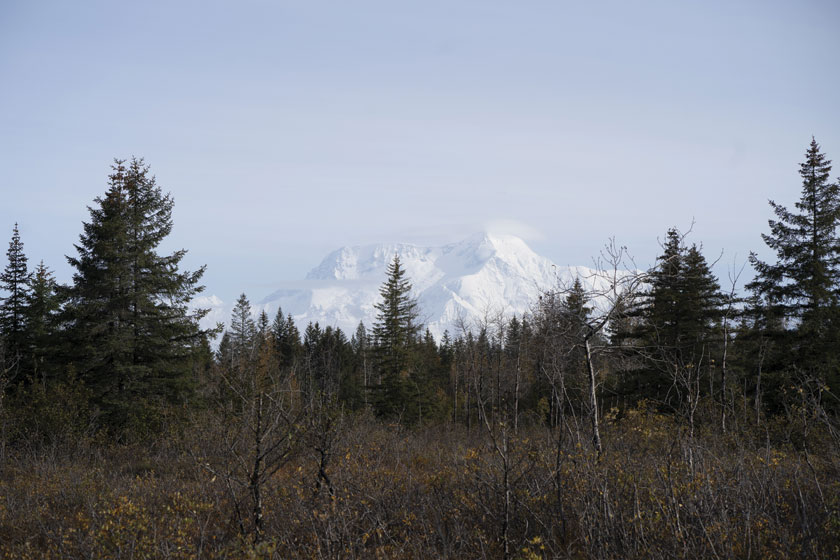
Mesmerizing views of the Wrangell and St. Elias Ranges emerge when the clouds dissipate.
My main strategy in moose hunting is to find good looking spots—meadows, ponds, rivers, etc.—and to focus my efforts in calling from these locations. Many hunters have their own opinion on how often to call, bull grunts versus cow calls, how often to rake the brush, etc. My general plan is to call in a 30-minute sequence, to be quiet for 90 minutes, and then repeat. I’ll start with several loud cow calls that sound like “Eeeew” then wait a minute and make several bull grunts sounding like “Uhhh”. I will wait for a few minutes, then rake brush for several minutes, mimicking the sound of a bull scraping the brush with its antlers. Then I will pause for several minutes and repeat the process, but move around within a 50-yard circle, making it sound like there are multiple animals and making it more attractive for a bull to come check it out.
In my opinion, patience is the single biggest key to success in moose hunting. Moose can take several days to come to a call, so picking likely looking moose habitat, sticking to your plan, and remaining vigilant during the entire day, will lead to more tags filled. One of the biggest mistakes that moose hunters make, especially in terrain that is flat and difficult to glass, is to walk around attempting to spot and stalk a bull. Stay put, call moose to you, and your odds will increase substantially.
An additional thought, especially in country that is flat, is to climb a tree. Look for a spruce with sturdy boughs, and consider bringing a handsaw so you can cut a shooting lane and clear yourself a space to sit. Being in a tree will give you far more visibility than being on the ground.
Don’t forget that you share the woods with bears. Use the best practices in bear country: Make noise when hiking, don’t leave food where bears can get to it, try to cook away from where you sleep, and generally keep your head on a swivel. When taking an animal apart do not leave anyone alone. If there are only two in your party, stay together and watch each other’s backs. Bears generally don’t want to have anything to do with you, and if you take the necessary precautions, you can usually avoid confrontations.
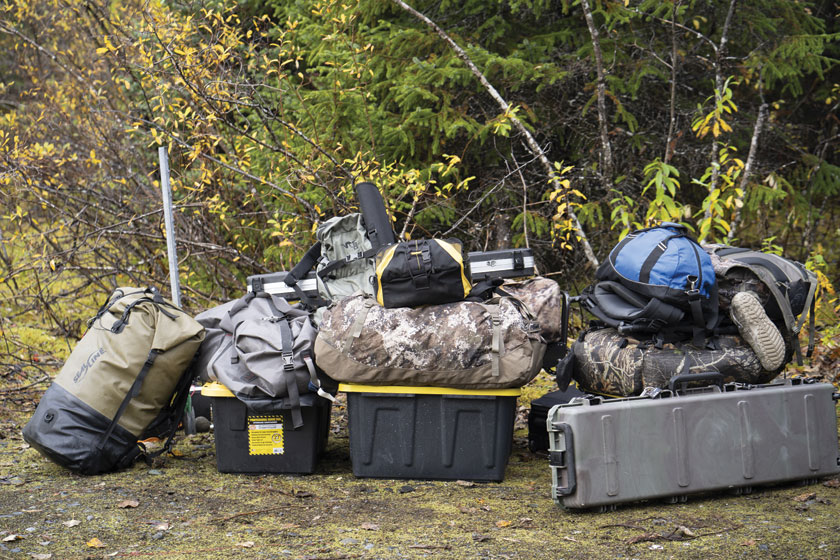
Our gear for this DIY hunt. Note the black totes which were used to transport gear into the field and then used to haul processed moose back home.
Tools
Since transporters can’t provide any tools to aid in your hunt, you will be stuck with whatever you bring. Here’s a list of the items we consider mandatory when DIY moose hunting:
- Sharp knives and knife sharpeners: We used a DiamondBlade Knives Folding Summit and their Boning Knife to take apart this moose. Spyderco makes many fine options as well. Some of our favorites include the Moran Drop Point, Serrata and South Fork. A good sharpener, like those made by Work Sharp, is also an essential tool.
- Pack: Your pack needs to be stout enough to haul a rear quarter of a moose, which can weigh upwards of 150 pounds on a big animal. I used a Stone Glacier Krux Evo frame to haul out this moose and it worked very well. You can add various-size bags to this frame to make the pack imminently multifunctional. I like the Sky 5900.
- Boots: Boots are a personal preference but need to be rugged, should be waterproof and provide solid ankle support to handle big loads. We love Kenetrek boots and generally wear the Mountain Extreme 400. At Icy Bay Lodge, you’ll also want to bring a set of hip waders such as Chota Hippies and a pair of wading boots like Korkers Terror Ridge or even chest waders and wading boots. There’s plenty of water and the rainy season will add to it.
- Rain Gear: Hunting big game in Alaska generally means rain. A good set of rain gear that will keep you dry is essential for safety and comfort. If you are going to wear camo, consider Sitka Gear, Kryptek or Kuiu. On this adventure, I stayed dry in Sitka Gear’s Stormfront Jacket and Pants. If you aren’t going to wear camo, then we recommend Grundéns. They’ve got several GORE-TEX sets that I recommend including the Buoy X and Downrigger. For many years I hunted blacktail on Kodiak using various Grundéns sets as my outer layer. Make sure your raingear is good enough that it won’t get torn to shreds by the underbrush. Also bring a good pair of gloves. Like everything in Alaska, the underbrush is rugged and can tear up your hands.
- Moose Call: I use the call made by Wayne Kubat called the Bull Magnet. It’s rugged enough that I can use it to both call and thrash brush. It’s light enough that it is easy to pack and has survived many trips. The device both amplifies your sounds and gives the calls a nasal quality which increases authenticity.
- Game Bags: We used Alaska Game Bags for this trip and always have good results with them. T.A.G. bags by Pristine Ventures are also a good choice. Make sure whatever set you bring is large enough to handle a moose. I recommend a set with eight bags. Game bags allow air to circulate around the meat, are strong enough to handle heavy loads and help keep the meat clean and dry.
- Sawzall: We have found that it is worth the weight to have a battery-powered Sawzall around when it’s time to butcher a moose. We use it for three primary tasks: cutting off the lower legs on the four quarters, removing the two sets of ribs, and removing the head for a European mount or skull plate with antlers. If you can’t bring a Sawzall, make sure you have a sturdy handsaw for these tasks. Consider the Mano Saw from RaptoRazor.
- Paracord: This type of rope is light, strong and multifunctional. The primary reasons to bring paracord are to hang game bags from a meat rack, secure tarps, and to create clothes lines to hang gear to dry.
- Firearm and Ammunition: This is a personal preference. I believe you should shoot the biggest caliber in which you are comfortable and confident. A well-placed shot from a smaller caliber is much better than poorly placed shots from larger calibers. I shoot a .300 Win Mag and use 190-grain, Winchester Expedition Big Game bullets.
- Tarp: I’ll use a tarp to lay below my filled game bags, then bring it back to camp and hang it over the meat rack. In some locations, dragging the quarters from the kill site to the transportation pick-up location is possible, and a heavy-duty tarp has worked for me in the past to haul meat.
- Boxes for meat transport: I use heavy-duty, 27-gallon totes that I purchased at Costco for my meat boxes. They can easily hold 100 pounds of deboned meat. I’ll use the totes to ship my gear to the hunt location and bring dry bags with me to use to ship my gear home in on the plane. These heavy-duty totes are reusable and up to the abuse. You’ll want to either wrap your meat in plastic wrap then butcher paper, or vacuum seal each piece, then freeze the meat before transporting home on the airline of your choice.
- Garden Hose Sections: I typically fly on Alaska Airlines, and they require that each point on the moose rack is covered. I use small chunks of garden hose and duct tape to cover each point.
- Plastic Wrap: This will come in handy both in wrapping meat and in wrapping the skull or base plate for transportation. Check with your airline on regulations for transporting skulls and antlers.
- Duct Tape: There are numerous uses for duct tape, so bring a roll or two. You will need to secure whatever padding you put on the tips of the antlers and tape down the lids of your meat boxes. In a pinch, you can do a lot with duct tape.
- Meat Thermometer: This handy device will allow you to monitor the internal temperature of your meat.
- Communication Device: On this hunt I brought a ZOLEO satellite communication device. It uses a smart-phone app in conjunction with the device to access the satellite communication network to allow you to send texts and emails. It made it possible to stay in touch with my family, business and transporter. I’d highly recommend purchasing one if you travel off the grid and need to remain in touch. I used it successfully in many locations around Alaska in 2020.
- First-Aid Kit: A good first-aid kit, like the Adventure Medical Kit Sportsman Series, will have a wide range of supplies that could be useful in the field. I brought the Sportsman 300 with me on this hunt. Since cuts are the most-common ailment, I added more Band-Aids to the kit.
- Bug Net: This is a very nice thing to have if the wind dies off or the sun comes out when you are dressing a downed moose. We’ve been gnawed on before by no-see-ums and it’s not too pleasant.
Once the Moose is Down
The real work starts when the moose is down. As responsible hunters, the first task is to remove all the meat from the carcass. Keeping it as hair-free, cool, clean and dry as possible will result in more and better-tasting game in the freezer. ADF&G mandates that you take the following meat when you butcher a moose: all of the neck meat, all of the chest meat (brisket), all of the meat of the ribs, front quarters to the knee, hindquarters to the hock, and all of the meat along the backbone (backstraps and tenderloins).
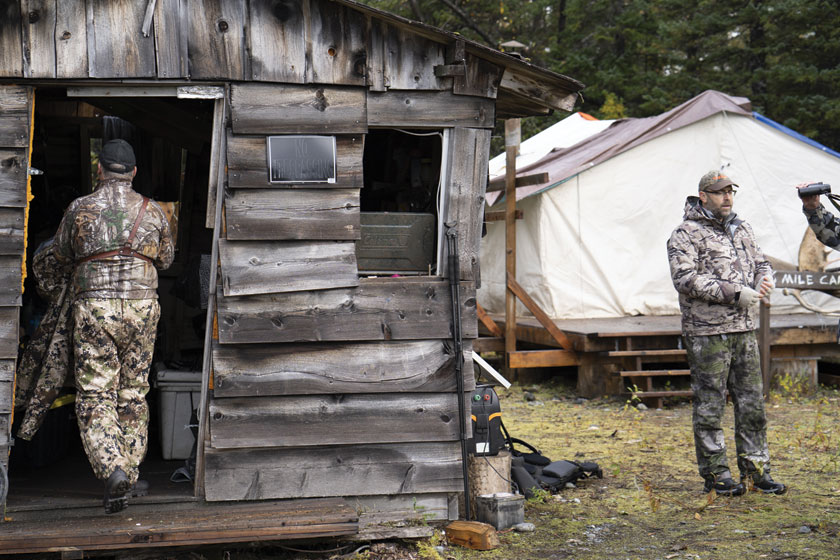
Home base for our five-day hunt. Icy Bay Lodge also has two cabins for hunters that are located on other portions of the property.
I prefer the gutless butchering method. The main concept is to start with the bull on its side, and peel back the hide on that side. I start by making an incision, cutting the skin and hair but not the meat, behind the head and work down the spine to just before the tail. Then I will begin to remove the hide on the first side. When you have one person to pull on the hide and another two to skin the animal, then the process goes quickly.
Once you have skinned out the first side and removed the hide from the two quarters to down below the knee, then it’s time to remove the two quarters. The rear quarter is attached through the hip socket, and a knife is all that is needed to separate the socket. Have one or two people push up on the rear quarter to expose the inner thigh and cut all the way around the quarter. Use the knife to take apart the socket, and the rear quarter is now free. At this point, remove and discard the lower portion of the quarter below the hock with the Sawzall. There is no salvageable meat here and this will reduce some weight for the pack out. You will do the same thing below the knees on the front quarters. Place in a game bag and onto a tarp to help keep it clean and dry.
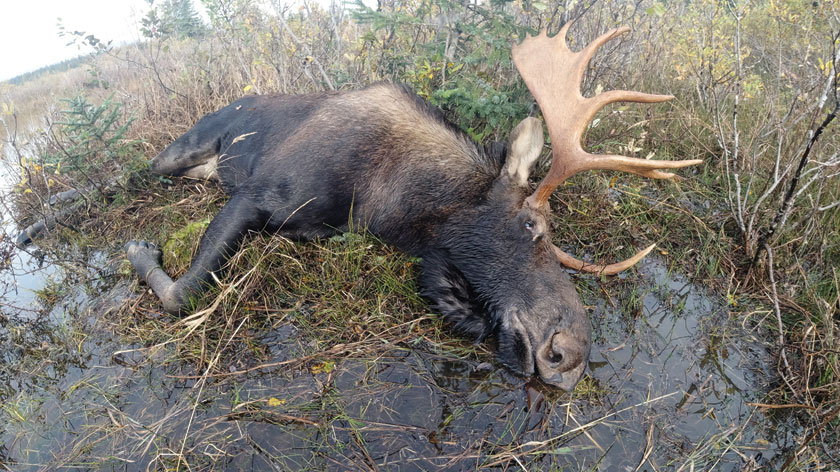
For hunters who have never shot a moose, then the size of the animal on the ground can be daunting. Take your time and carefully remove all the meat from the carcass. It’s some of the best-tasting game meat on the planet.
The front quarter is attached through the shoulder blade, or scapula, and is easily removed by following the bone with your knife. Remove the quarter and place in a game bag. Next, remove the backstrap, which is located on either side of the spine. I like to dedicate one game bag to backstraps and tenderloins. Next, remove the brisket and neck meat and place in a bag. At this point, you can either remove the ribcage, or cut the meat off the rib cage. I prefer to cut out the ribcage and remove the meat back at camp. If you’ve brought a Sawzall, then you will really appreciate this tool while you cut out the ribcage. Next, remove the tenderloin, located behind the ribcage and towards the rear. Finally, either remove the antlers by cutting off the skull plate, or take the entire head if you are having a European mount made. Roll the animal over and repeat the process.
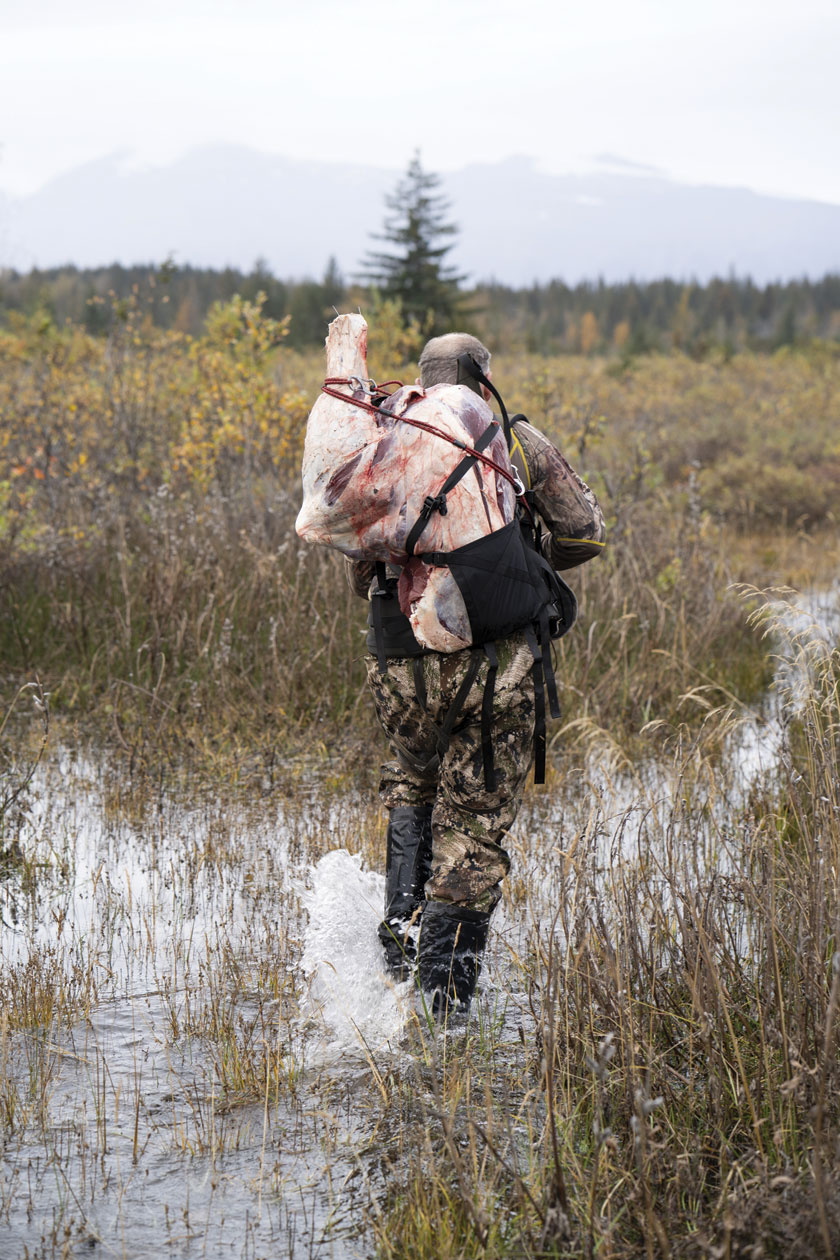
Kirk packs out a front quarter.
Be sure to check regulations in the GMU you will be hunting. Some require that the bone is left in the quarters when you pack out of the field, while in some GMUs it is legal to remove the bone. I prefer to keep the meat on the bone because it is easier to keep the meat cool and dry on the bone versus in chunks off the bone. You must leave the proof of sex on the rear quarter until you process the meat for consumption; antlers are not proof of sex. There are sealing requirements for some GMUs, like 7 and 15. Sealing means having an authorized ADF&G representative place a seal on an animal hide and/or skull. Other GMUs, like 5B that I hunted in for this article, require that successful hunters must submit the lower front teeth on a 5-inch section of jaw within five days of the kill. When packing out a moose, the antlers are the last thing to come out of the field. Do your homework and know what rules need to be followed. If you are unsure, call ADF&G.
When you get the meat back to camp, you will need to hang the bags off the ground to keep it dry and cool. Most hunters erect a meat rack. If that’s not possible, pile sticks and brush on the ground to create some space to get the meat off the ground and allow for airflow. Place a tarp over the meat to shield from rain and direct sun. If it’s below freezing, then a process called cold shortening can affect the quality of the meat and make it tough. This happens when the meat freezes too quickly, before rigor mortis and then subsequent relaxation of the muscle fibers, can occur, generally within the first two days of harvest. Consider heating up the area (a backpacking stove will work) to bring the temperature up if this is happening, and bring a meat thermometer to monitor if the meat is getting too hot or too cold. Temperatures over 60 degrees increase bacteria growth and meat spoilage, so remain diligent in checking your meat and remove any spoilage ASAP. Your nose is a vital tool when inspecting meat. Err on the conservative side by removing anything that smells like it may be spoiling. Optimum temperature for the meat is between 40-50ºF.
Further DIY Moose Hunt Insights
Many hunters underestimate the amount of work it takes to field dress and pack out an animal that can weigh 1500 pounds or more. Take the planning, fitness and preparation seriously, and a moose hunt is one of the great bucket-list items for many big-game hunters. Don’t take it seriously and you may find yourself in a difficult spot.
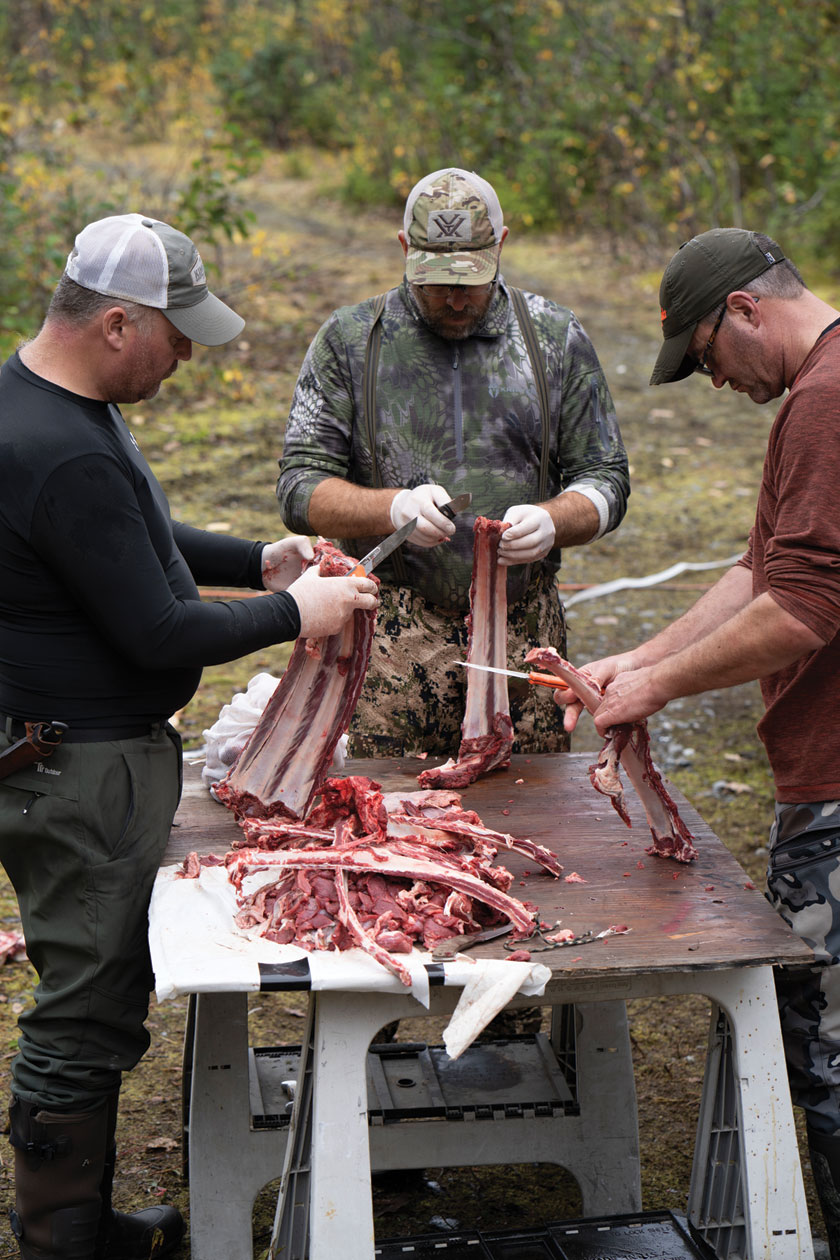
Kirk, Brett and Marcus trimming meat from the rib cages. The use of a Sawzall reduced the amount of elbow grease needed.
Many hunters do the pre-trip work, but then throw out the game plan when they get into the field. Hunts have been ruined when the hunter loses patience and tries to spot and stalk, rather than sitting in one location, glassing and calling. It’s not to say that some country isn’t suited to spot and stalk for moose, but in my opinion, you will have more success if you sit still, glass and call.
I seriously caution you to maintain a maximum distance you are willing to pack the moose, because injuries and even heart attacks are possible if you over stress your body. And lastly, there are many resources available to learn how to properly field dress a moose, and it’s our ultimate responsibility as moose hunters to harvest all the usable meat and to treat the animal with respect. Moose meat is some of the best-tasting game meat in Alaska and all of it should be harvested for consumption.
Be reasonable regarding the time it takes to field dress a moose, and then the amount of time needed at camp to break down the meat for human consumption. With three experienced hunters butchering the moose, and a short pack, we were able to get the job done in three hours, which is very fast. It took four of us, three cutters and one man on the vacuum sealer, six hours the following day to reduce the field-dressed sections into deboned meat ready to be frozen. Don’t underestimate how much time it will take to transform a downed animal into meat ready to travel on a commercial airline.
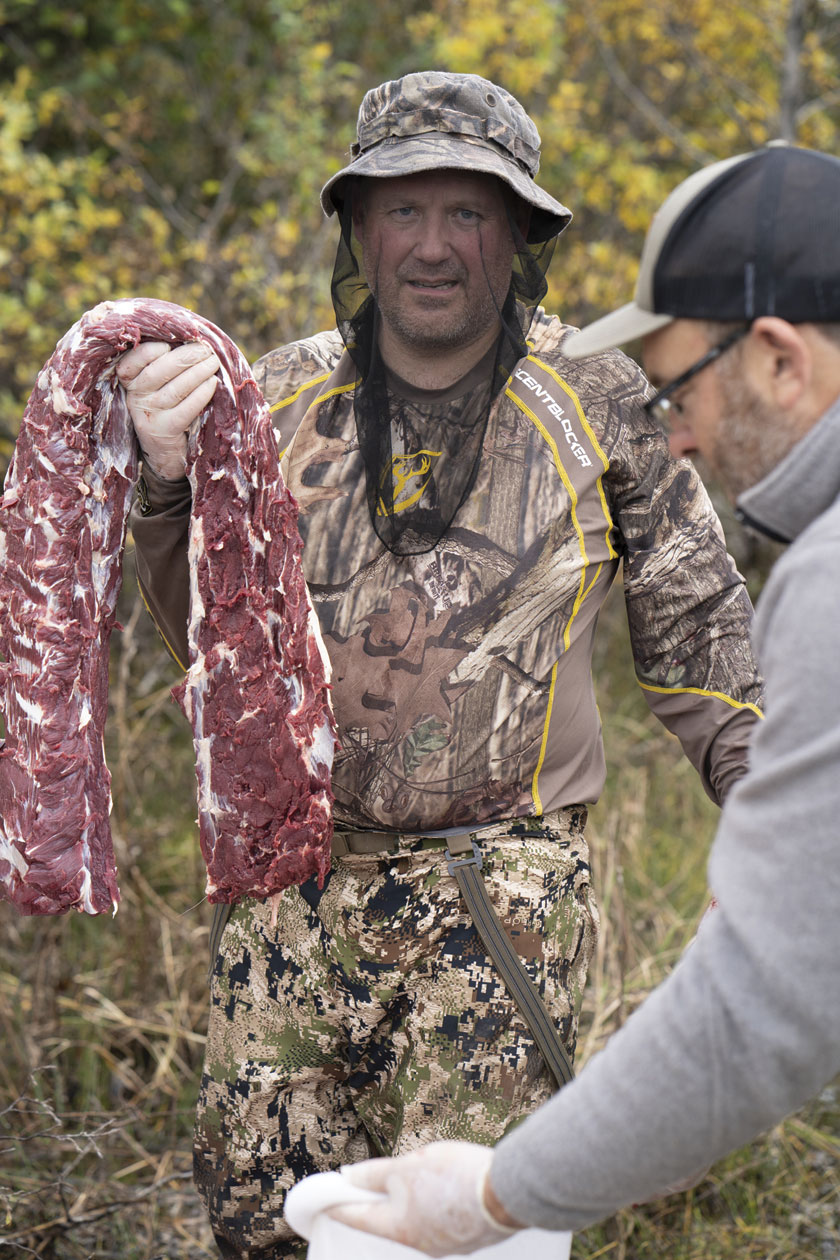
Moose backstraps are big. Many delicious meals will be made from this cut.
Moose populations in Alaska are strong, with estimates of up to 200,000 moose roaming the Great Land. But since the state is extraordinarily large, there’s not a moose in every pond. Don’t arrive expecting to see tons of animals like you might on a Midwestern whitetail hunt. Chances of success are good, but expectations should be reasonable about game density.
Finally, give yourself plenty of time to enjoy your moose hunt. We did this one in only five days and it was too short. I’d say give yourself a solid 7- to 10 days to hunt. This will give you time to learn the country, find some moose, possibly take a bull, and break it down to take home.
From moose cheese steaks, to moose breakfast sausage, moose chili, tacos, meatballs, and stew, my family has been thoroughly enjoying the rewards of the hunt. I’m already talking to Todd about the next one.
Marcus Weiner is Founder and Publisher of Fish Alaska and Hunt Alaska magazines.
This article originally appeared as ‘DIY Moose Hunting in Icy Bay’ in the Spring 2021 issue of Hunt Alaska.
